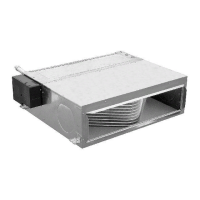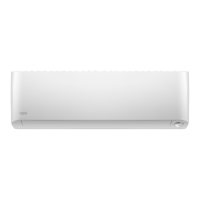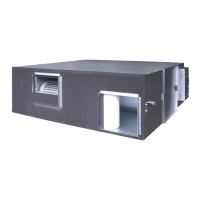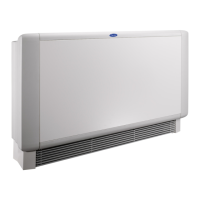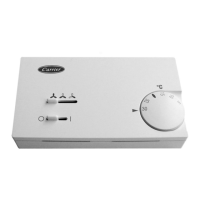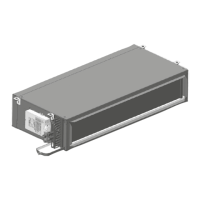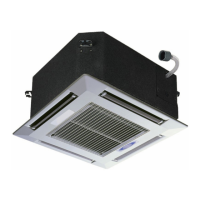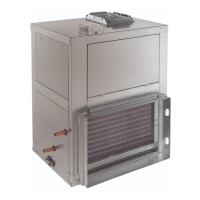42
Electric Heat — Two control relays are factory-supplied,
factory-installed and factory-wired to provide staging control
for electric heater applications. They are used to operate the
electric heater elements in two stages. The relays are installed
inside the electric heat control compartment. The heater circuit
connections depend upon the actual number of heater elements
provided. The Unit Ventilator Comfort Control module pro-
vides two stage electric heat control capability unless only one
element is provided.
The control operates the heater stages as required, but pre-
vents the discharge air temperature from exceeding 140 F at
any time.
The first stage is wired so that it operates between 33 to
50 percent of the total heater capacity. Refer to Table 16 for
heater element circuit connections.
Remote Start — The remote start input is used to switch
the control operating mode from the unoccupied to the occu-
pied state by means of a contact closure from an external con-
trol system or an electro-mechanical time clock device. The
control device must provide an isolated single-pole contact.
Whenever the contact is closed and 24 vac is present on T20,
the control will operate in the Occupied mode.
Using 18 or 20 AWG wire, connect the remote start termi-
nal (T20) to one side of the remote contact. Connect the other
side of the contact to TB.
If a solid-state contact is provided by the control device,
then a field-supplied and field-installed load resistor may be
necessary to ensure reliable operation of the input. To ensure
proper operation, use a digital volt meter (DVM) and measure
the AC voltage between T20 and T25 with the external contact
in the OFF or open position.
The input will operate properly if the AC voltage is less than
1 vac, otherwise a load resistor must be connected across termi-
nals T20 (remote start input) and T25 (ground). Typically, a
single 1000 ohm, 2 watt resistor will reduce the voltage suffi-
ciently for most solid-state contacts. If not, add additional resis-
tors, one at a time, until the voltage measured is below 1 vac.
Because the resistors heat when operating, the devices should
be permanently mounted to a field-supplied terminal strip and
20 AWG wire rated for at least 90 C should be used to connect
the resistor(s) to control terminals T20 and T25.
Fire/Smoke Status Input — The Fire/Smoke Status
Input is used to identify that a fan has stopped its normal opera-
tion due to an alarm condition at a local fire or smoke detector.
This input must be used in conjunction with a normally closed
contact which is wired into the fan motor control circuit.
A double-pole double-throw (DPDT) relay, part number
HN61KK324, is recommended. One set of the relay contacts is
wired into the fan motor circuit and the other set is wired to the
control input. The control box provides 24 vac power for the
relay. The relay is controlled by a separate isolated contact set
from the smoke or fire detector.
All wiring from the detector should be appropriately rated
for the application and must comply with NEC, NFPA (Nation-
al Fire Protection Association) and any local codes.
SMOKE/FIRE DETECTOR WIRING (Normally Open
Contact Set) — Perform the following procedure to wire the
smoke/fire detector:
1. Use15AWGwireratedfor600vacforallwiring.
Eight
1
/
4
-in. insulated female quick-connect type lugs
are required.
2. Connect a wire from TB to one of the detector contact
terminals.
3. Connect the other detector contact terminal to the relay
coil terminal no. 1.
4. Connect the other coil terminal, no. 3, to ground in the
control box.
5. Connect the normally closed contact set (relay termi-
nals no. 5 and no. 6) to the fan motor wiring as shown
on the label diagram.
6. Connect one of the normally open relay contacts, ter-
minal no. 2, to TB (24 vac).
7. Connect the other side of the contact, terminal no. 4, to
T21 on the control module.
SMOKE/FIRE DETECTOR WIRING (Normally Closed
Contact Set) — Perform the following procedure to wire the
smoke/fire detector:
1. Use15AWGwireratedfor600vacforallwiring.
Eight
1
/
4
-in. insulated female quick-connect type lugs
are required.
2. Connect a wire from TB to one of the detector contact
terminals.
3. Connect the other detector contact terminal to the relay
coil terminal no. 1.
4. Connect the other coil terminal, no. 3, to ground in the
control box.
5. Connect the normally open contact set (relay terminals
no. 2 and no. 4) to the fan motor wiring as shown on
the label diagram.
6. Connect one of the normally closed relay contacts, ter-
minal no. 5, to TB (24 vac).
7. Connect the other side of the contact, terminal no. 6, to
T21 on the control board.
Table 16 — Heater Element Wiring
TOTAL NO.
OF HEATER
CIRCUITS
NO. OF CIRCUITS
CONTROLLED
BY STAGE 1
STAGE 1
CAPACITY (%)
NO. OF CIRCUITS
CONTROLLED
BY STAGE 2
STAGE 2
CAPACITY(%)
3 133267
4 250250
5 240360
6 233467

